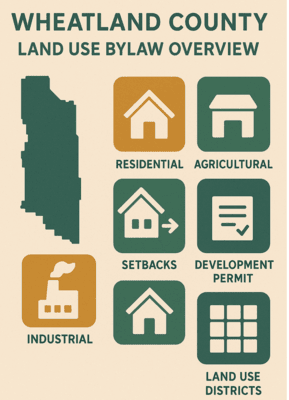Wheatland County has specific regulations in place to guide property development. These regulations cover setbacks, building heights, and land use requirements across various districts. Below are the key points to consider when purchasing property in the county:
- Minimum Setbacks: Property setbacks vary depending on the type of development. For example, the rear yard setback is typically 22.86 meters (75 feet) from a public road right-of-way.
- Building Height Restrictions: Residential properties generally have a maximum height of 10.05 meters (33 feet) for principal buildings, while accessory buildings can reach up to 5.48 meters (18 feet).
- Lot Coverage: There are limits on how much of the lot can be covered by buildings and impervious surfaces. The maximum coverage is 60% for single-family residences and up to 85% for agricultural uses.
- Land Use Bylaw Requirements: Certain uses, such as agricultural operations, require additional approvals, and the county may refuse applications for development permits if the land is deemed unsuitable for the proposed use.
- Special Development Considerations: Development on lands within certain districts (such as residential and agricultural areas) may require specific site plans, stormwater management, or consultation with environmental agencies.
Regulatory Overview
It is crucial to adhere to Wheatland County's Land Use Bylaw (LUB 2016-01), which governs both residential and commercial properties. Additional requirements may include landscaping, fencing, and screening guidelines, ensuring that new developments are in harmony with the surrounding community.
Environmental Considerations
For properties near floodplains, wetlands, or other environmentally significant areas, an Environmental Impact Assessment (EIA) may be required. It is important to evaluate the environmental impact before proceeding with development.
Land Use Districts
Wheatland County is divided into multiple land use districts, each with its own regulations. For example, agricultural districts allow farming and related activities, while residential districts are for homes and minor accessory uses. Always check the zoning for your property before proceeding with development plans.
Subdivision Process
If you are considering subdividing your property, Wheatland County has a specific application process that must be followed. This includes submitting subdivision plans for approval and ensuring the proposed subdivision adheres to the county’s land use regulations.
Permitted and Discretionary Uses
Properties in Wheatland County can fall under either "permitted" or "discretionary" use categories. Permitted uses are automatically approved if they meet all criteria, while discretionary uses require further approval and may be subject to additional conditions. Always verify which category your planned use falls under.
Utility Requirements
Developers should consider the availability of public utilities such as water, sewer, and electricity. If public utilities are not available, private systems may need to be installed, which can involve additional costs and planning.
Development Agreement
For certain developments, you may be required to enter into a development agreement with Wheatland County. This legally binding document outlines the obligations and requirements for the development project.

